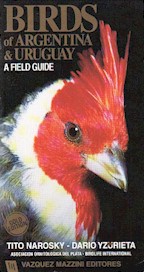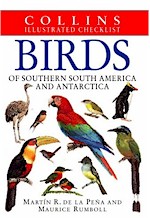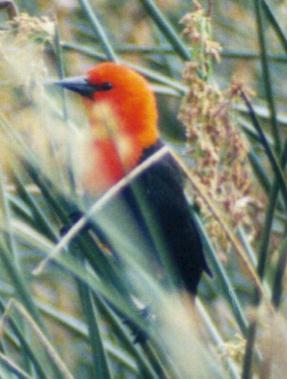Last update: September 2008
Portal en Español
|
|
Website created and maintained by: Alec
Earnshaw
Last update: September 2008 |
Marca aquí para ir al
Portal en Español |
|
Ribera
Norte is ideal for birding
|
| BIRDING
FIELD GUIDES For your birding trip to Argentina there are basically two books to choose from, available both locally and internationally: |
|
 |
"Guía
para la Identificación de las Aves" (EDICION DE ORO) (in Spanish) por Tito Narosky y Darío Yzurieta - Vazquez Mazzini Editores - ISBN: "Birds of Argentina & Uruguay - A field guide" GOLD EDITION (in English) by Tito Narosky & Darío Yzurieta - Vazquez Mazzini Editores - ISBN: 987-9132-05-X Revised and expanded "Gold Edition" was published in June 2003. Purchase at Aves Argentinas (NGO) bookstore Address: Matheu 1246/8 Call (54-11) 4943-7216 to 7219 after 2 pm to check availability of English edition. Or contact the publisher: Phone (54-11) 4546-2416 |
 |
"Birds
of Southern South America" |
|
I rather prefer the first - in spite of being pricier - since the drawings are more accurate (though not necessarily more attractive). With it you are likely to be more successful at identifying (especially with ducks and raptors). An important advantage is that the distribution maps are right alongside each bird species. Because the country is large and there are so many species (approx. 1,000), you'll probably need to refer to the maps a great deal, especially on a first visit. |
|
| SOME OF THE BIRDS YOU MIGHT SEE AT RIBERA NORTE | |
| BIRD
LISTS Checklist This is a list of all the species I have seen here, plus some additional species that have been recorded. This is a "printer-friendly" file that fits on a single letter-sized sheet so you can bring it with you to "tick off" the species. Sightings made during 1999: Check out the bird sightings for each visit I made with my son in 1999 (text is fully bilingual). Each column represents the month of the year. |
|
|
Scarlet-headed
Blackbird
(Amblyramphus holosericeus) I think this has got to be one of the most brilliantly-coloured birds you'll ever see in Argentina! The limitations of paper film do not do full justice to its marvellous plumage.  Photo: (c) A. Earnshaw |
Some
Common birds : Rufous-Collared
Sparrow, Great Kiskadee, Rufous-bellied Thrush, Common Gallinule, White-Necked
(Cocoi) Heron, Eared Dove, White-Tipped Dove, Monk Parakeet (overfly).
Birds
that are often easily seen (or heard): Other common birds. Masked Gnatcatcher, Narrow-billed Woodcreeper, Scarlet-headed Blackbird (virtually no sightings through the 2007-2008 summer), Yellow-winged Blackbird (recently has become rare), Shiny Cowbird, Bay-winged Cowbird. Raptors & owls: Roadside Hawk, Crested Caracara, Chimango Caracara (overfly), Bay-winged Hawk (less common). Owls: Great Horned Owl (temporary in winter), Striped Owl (bred 2 chicks July-September 2004). Common
Winter Visitors: White-tipped Plantcutter, Various gulls (overfly
or seen on beach at low tide), Golden-crowned Warbler, Tropical Parula. |
| Some basics about birding in Argentina | |||||||||||||
|
Argentina is a fairly big country that boasts a huge latitudinal range. This implies a wide diversity of climates and habitats, with many areas still with natural vegetation. This includes rainforests, arid bushland, marshes, inland lakes, grasslands, high mountains, etc. (The Aconcagua, on the andean border between Chile and Argentina, is the highest mountain of the American continent.) As a result of this diversity, the country hosts over 1,000 species of birds (including pellagic and antarctic species). But in order to tick off 50% of them you might have to travel the country end-to-end, or visit at different times of the year. But that is beyond the scope of this short summary, so letís start with some basics: our national bird, and then take a quick look at the very common species you are sure to see in Buenos Aires city parks, the town most likely to be your entry point. | |||||||||||||
| |||||||||||||
|
In the city parks you may see a number of common birds, especially if you look out for them. Before I visit a foreign country as a tourist or on business I am overwhelmed by all the new birds covered by the fieldguides In such cases it would be nice to have a short list of the very common fare, those that one would certainly want to see, but then put aside and not confuse with more interesting stuff once you get to a nature reserve. Here then is a basic list you might wish to "study up" before your first visit to Argentina. It covers the MOST common fare. You will still need a guide book, but at least you'll know which to concentrate on. House
Sparrow (Passer domesticus) Flycatchers: Prepare to see and hear the Great Kiskadee (Pitangus sulfuratus). This is a very common bird. Yellow belly. Black across eyes. White above and below this black facial mask. The black crown hides a yellow crest, visible only when the bird is in "high state of alert". One possible transcription of its call is "kiss-ka-dee". I suspect this comes from French: Qu'est-ce qu'il dit" - or "What's he saying"?? :)) The call has also given the bird its vernacular names in Spanish: "Ben-te-veo", (or also "Bicho Feo" [pronnounced beech or fayor], which means "ugly critter"). Other calls are also common, such as a haggish "wehh", or some nasty and aggressive trills or clickety sounds. Doves: The cosmopolitan Rock Dove is here too, but you should also see the smaller Eared Dove (Zenaida auriculata) (note few black spots on back) or the large Picazuro Pigeon (Columba picazuro) (note the colourful pattern on rear of neck. Identify by it's large size and, in flight, by the whitish crescent marking on upper side of wings). Thrushes: The Rufous-bellied Thrush is very common, and the only thrush you are likely to see in a Buenos Aires park (though there is also the Creamy-bellied Thrush which is likely seen at nature reserves). I don't live in a downtown hotel, but I suspect that even from your room you might hear it's insistent and lively song, which begins at the annoying hour of about 3:30 am every day in Spring ans Summer, from September onwards. Mockingbird: The Chalk-browed Mockingbird (Mimus saturninus) is common. Whitish brow and long tail. Strange calls: William. H. Hudson recalls a memorable encounter with one: he describes how a variety of very odd calls coming from a dense bush seemed to be the produced by 3 or 4 different bird species, but they all proved to be from a single mockingbird! In
parks you may also see House Wrens and White-rumped Swallows
(in spring and summer), Cattle Tyrants, Shiny Cowbirds,
Bay-winged Cowbirds, Picui Ground-Dove, etc. | |||||||||||||
| RIBERA NORTE NATURE RESERVE | |
|
This
is an interesting place in Acasusso (northern suburbs of the city), where
you are likely to see many rails. If you have not already done so, GO
TO THE ENGLISH-LANGUAGE HOMEPAGE OF THE RIBERA NORTE WEBISTE
(which contains the page you are seeing now).
In
favour of Ribera Norte: In
favour of Costanera Sur: Against
Costanera Sur: |
| GUIDING
- Please take note I offer full-day worry-free birding trips to the best
hotspots in the Buenos Aires area. We can visit productive nature reserves
or inland country areas with spectacular habitats that will really "up"
your list. Spring/summer species count should easily top 100 spp., and in
winter you can expect about 80 spp. I can provide an English-language field
guide and checklist for the outing. I provide transport and sort out meals
for the day. I am normally available on weekends, but can sometimes accomodate
a weekday as well. If you are interested kindly email me. Alec Earnshaw |
|
|